Do you have a question about the Bostitch BTFP02006 and is the answer not in the manual?
Defines signal words like DANGER, WARNING, CAUTION, NOTICE for safety information.
Instruction to keep manual for future reference and review safety warnings.
Guide to familiarize with unit's controls and safety rules before operation.
Describes the function of the power switch for controlling the unit.
Explains how the switch starts and stops the motor based on tank pressure.
Details the valve that automatically releases air from the head/tube.
Explains the valve's role in protecting against over-pressure if the switch fails.
Describes how the valve allows air into the tank and maintains pressure.
Covers the connector that accepts various plug styles for easy hose attachment.
Indicates the current air pressure stored within the tank.
Shows the air pressure available at the regulator outlet for tools.
Explains how to adjust and lock the desired air pressure output.
Location and function of the valve used to drain condensation.
Describes the fan and vent system for cooling the compressor unit.
Explains the function of the pump in compressing air into the tank.
Details the safety feature that shuts off the motor if it overheats.
Explains how to check the oil level in the pump using the dipstick.
Describes the filter's role in cleaning intake air for pump efficiency.
Instructions for assembling the compressor, including fitting wheels and bumper.
Step-by-step guide for attaching the wheels and bumper to the compressor unit.
Procedure for safely attaching air hoses to the quick connect fitting.
Procedure for safely removing air hoses from the quick connect fitting.
Specifies the correct oil type and warns against using multi-viscosity or overfilling.
Emphasizes the importance of proper grounding for electrical safety.
Provides guidance on using extension cords, including recommended gauge and length.
Outlines requirements for electrical circuits and protection like fuses/breakers.
Discusses compatibility of air tools and the need for air line filters when spraying.
Specifies ideal placement for the compressor in a clean, dry, ventilated area.
Lists essential pre-start checks for safe and proper operation.
Step-by-step guide covering switch, plug, tank drain, valves, and oil level.
Reminder to read manual and safety rules before operating the unit.
Essential steps for the initial run-in period before regular use.
Guide to starting the compressor, building pressure, and adjusting the regulator.
Steps for turning off the unit, depressurizing, and draining the tank.
Guidelines for storing the unit safely and transporting it without damage.
Instructions on how to safely lift the compressor unit.
How to safely move the compressor by rolling or tilting it.
General procedures to follow before performing any service or maintenance on the unit.
A table outlining daily, weekly, monthly, and yearly maintenance tasks.
Procedure to ensure the safety valve functions correctly to prevent over-pressure.
Steps to inspect, clean, or replace the air filter for optimal performance.
Daily procedure to remove condensation and prevent tank corrosion.
Instructions for checking the oil level in the compressor pump.
Detailed steps to read the oil level using the dipstick and add oil if necessary.
Step-by-step guide for draining old oil and refilling the pump with new oil.
Information on recommended accessories and where to obtain them.
Details to have ready for service calls, such as model and serial numbers.
Guidance on where to have repairs performed for product safety and reliability.
Outlines the terms and coverage of the product's one-year warranty.
Specific warranty information for products sold in Latin America.
How to obtain replacement warning labels if they become illegible or are missing.
Provides definitions for key terms and acronyms used in the manual.
Introduces a guide to identify and correct common malfunctions, their causes, and solutions.
Defines signal words like DANGER, WARNING, CAUTION, NOTICE for safety information.
Instruction to keep manual for future reference and review safety warnings.
Guide to familiarize with unit's controls and safety rules before operation.
Describes the function of the power switch for controlling the unit.
Explains how the switch starts and stops the motor based on tank pressure.
Details the valve that automatically releases air from the head/tube.
Explains the valve's role in protecting against over-pressure if the switch fails.
Describes how the valve allows air into the tank and maintains pressure.
Covers the connector that accepts various plug styles for easy hose attachment.
Indicates the current air pressure stored within the tank.
Shows the air pressure available at the regulator outlet for tools.
Explains how to adjust and lock the desired air pressure output.
Location and function of the valve used to drain condensation.
Describes the fan and vent system for cooling the compressor unit.
Explains the function of the pump in compressing air into the tank.
Details the safety feature that shuts off the motor if it overheats.
Explains how to check the oil level in the pump using the dipstick.
Describes the filter's role in cleaning intake air for pump efficiency.
Instructions for assembling the compressor, including fitting wheels and bumper.
Step-by-step guide for attaching the wheels and bumper to the compressor unit.
Procedure for safely attaching air hoses to the quick connect fitting.
Procedure for safely removing air hoses from the quick connect fitting.
Specifies the correct oil type and warns against using multi-viscosity or overfilling.
Emphasizes the importance of proper grounding for electrical safety.
Provides guidance on using extension cords, including recommended gauge and length.
Outlines requirements for electrical circuits and protection like fuses/breakers.
Discusses compatibility of air tools and the need for air line filters when spraying.
Specifies ideal placement for the compressor in a clean, dry, ventilated area.
Lists essential pre-start checks for safe and proper operation.
Step-by-step guide covering switch, plug, tank drain, valves, and oil level.
Reminder to read manual and safety rules before operating the unit.
Essential steps for the initial run-in period before regular use.
Guide to starting the compressor, building pressure, and adjusting the regulator.
Steps for turning off the unit, depressurizing, and draining the tank.
Guidelines for storing the unit safely and transporting it without damage.
Instructions on how to safely lift the compressor unit.
How to safely move the compressor by rolling or tilting it.
General procedures to follow before performing any service or maintenance on the unit.
A table outlining daily, weekly, monthly, and yearly maintenance tasks.
Procedure to ensure the safety valve functions correctly to prevent over-pressure.
Steps to inspect, clean, or replace the air filter for optimal performance.
Daily procedure to remove condensation and prevent tank corrosion.
Instructions for checking the oil level in the compressor pump.
Detailed steps to read the oil level using the dipstick and add oil if necessary.
Step-by-step guide for draining old oil and refilling the pump with new oil.
Information on recommended accessories and where to obtain them.
Details to have ready for service calls, such as model and serial numbers.
Guidance on where to have repairs performed for product safety and reliability.
Outlines the terms and coverage of the product's one-year warranty.
Specific warranty information for products sold in Latin America.
How to obtain replacement warning labels if they become illegible or are missing.
Provides definitions for key terms and acronyms used in the manual.
Introduces a guide to identify and correct common malfunctions, their causes, and solutions.
| Type | Pancake |
|---|---|
| Tank Capacity | 6 Gallons |
| Max Pressure | 150 PSI |
| SCFM at 90 PSI | 2.6 |
| Power Source | Electric |
| Voltage | 120 V |
| Pump Type | Oil-Free |
| Noise Level | 78.5 dBA |
| HP | 0.8 HP |
| Amperage | 10 A |
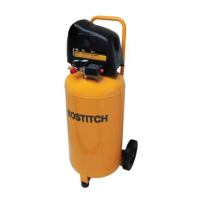
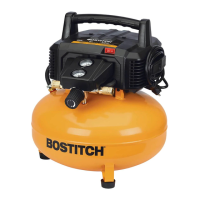
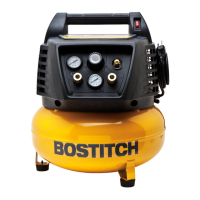
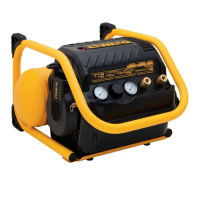
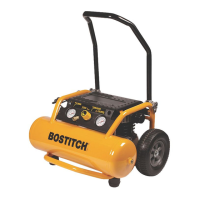
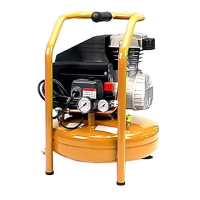
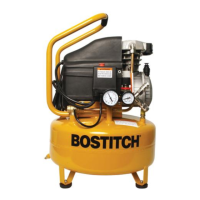
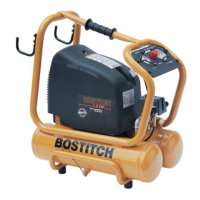
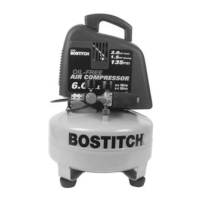

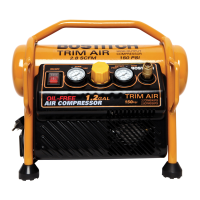
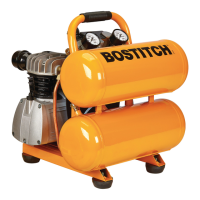
